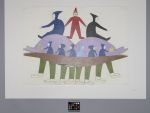Six Figures Inside Two Sea Spirits
About this object
History of use
The Inuit prints consist of stencils, stonecut engravings and lithographs from the communities of Cape Dorset, Baker Lake, Povunenituk, Holman Island, Pangnirtung, and Clyde River. The first Cape Dorset prints were in 1959, Povunenituk in 1962, Holman island in 1965, Baker Lake in 1970, Pangnirtung in 1973, and Clyde River in 1981. Since the late 1940's Indian and Northern Affairs have supported the development of art from the Canadian Arctic in co-operation with the Canadian Eskimo Arts Council. Catalogues have been published since 1959 and most of the prints are documented in their year of production. The community of Baker Lake is 320 kilometres inland from the west coast of Hudson Bay and has existed since 1916. In the 1950's the Inuit suffered great deprivation due to the reduction in the numbers of caribou. At this time, the federal government wanting to encourage economic independence sponsored an arts and crafts programme. In 1961-1962, William Larmour, an officer with Northern Affairs collected pencil drawings which convinced him that a graphic programme was feasible. Gabriel Gily, a French artist, came as Arts and Crafts Officer in 1963 to develop the print programme. Roderick McCarthy, who replaced Gily, supervised the programme and in August 1965 the first prints were enthusiastically received by the Canadian Eskimo Arts Council. The first collection, issued in 1970, contained 27 of the early prints. The Sanavick Co-operative was incorporated in 1971. The imagery of the prints is bold and brilliant in colour with an emphasis on shamanistic and supernatural subject matter with the common element of a strong tie to traditional life. The technique is usually stonecut and stencil.
Narrative
Balshine family collection.
Physical description
A drawing of three human figures above a two-headed sea creature with six human figures inside. Eight green human lower legs protrude from the bottom of the sea creature. The top human figures, from left to right, are wearing dark blue, red, and black clothing. The human figures inside the sea creature, from left to right, are wearing dark blue, dark blue, dark blue, light blue, dark blue, and dark blue clothing. The sea creature is light purple with a brown belly. On the reverse side, at the lower right corner, there reads 'F-4 350 Cap 4-112 Oonark'. Name of artist in Inuit syllabics at lower centre in pencil. The drawing is on horizontally rectangular white paper.
Categories
Materials
